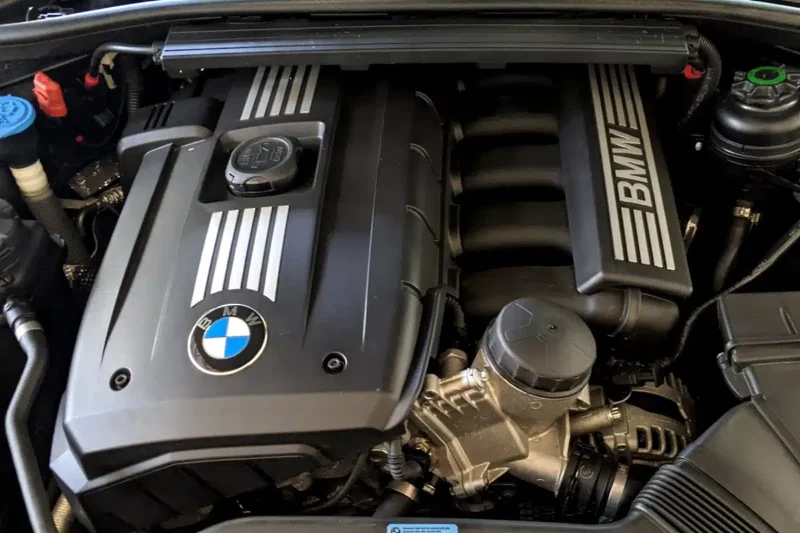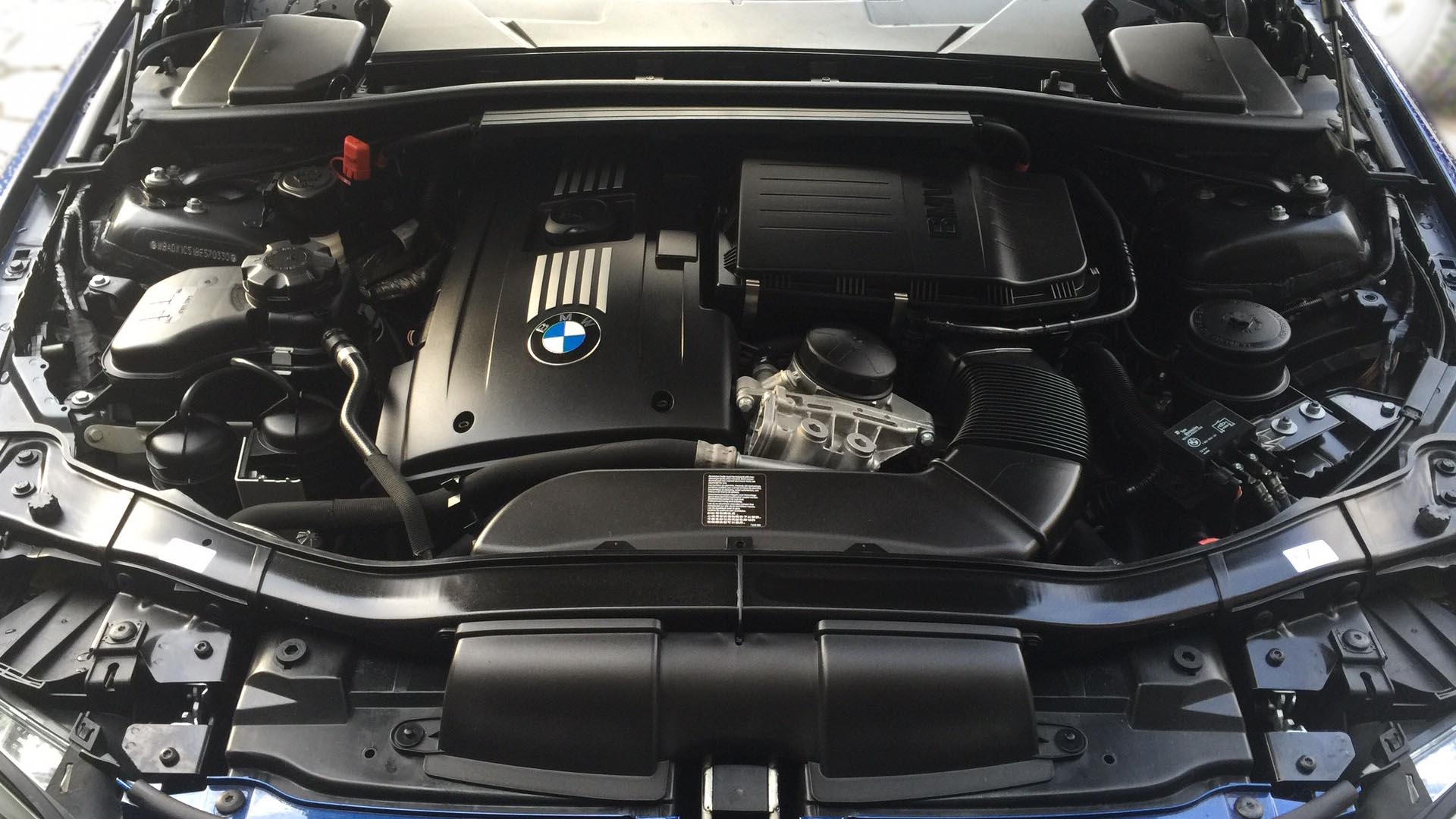The BMW N52 is an atmospheric inline six-cylinder gasoline engine that was produced from 2004 to 2015. The BMW N52 replaced the M54 and debuted in the E90 3-Series and E63 6-Series. The N52 was available in two variants, the N52B25 and N52B30, with displacements of 2.5 (2,497 cc) and 3 liters (2,996 cc) respectively.
The N52 was the first water-cooled engine to use magnesium-aluminum alloy composite construction in the cylinder block. It was also listed as one of Ward’s 10 Best Engines in 2006 and 2007 (Ward’s AutoWorld magazine).
In European markets, production of the N52 began to be phased out after the 2007 BMW N53, which was first released with the restyling of the BMW E60. However, in markets such as the US, Canada, Australia and Malaysia, the N53 was deemed unsuitable due to the high sulfur content of the local fuel. From 2011, the N52 began to be replaced by BMW’s turbocharged four-cylinder N20 engine until production of the N52 was ended in 2015.

Compared to its M54 predecessor, the N52 motor features for the first time fully variable Valvetronic valve actuation, a lighter block due to the use of magnesium alloy, and an electric water pump (replacing the belt-driven water pump). Thanks to the oil/water heat exchanger, the engine reaches operating temperature faster in the warm-up phase with intensive fuel consumption. At very high oil temperatures, heat is dissipated to the engine cooling system via the heat exchanger. The torque red line has been increased from 6,500 rpm to 7,000 rpm, with the exception of the N52B25 (177 hp).
Like the M54, the N52 engine utilizes electronic throttle control and dual VANOS (variable valve timing system). Higher power output versions of the N52 utilize a three-stage variable-length intake manifold (DISA). The three-stage resonant intake system results in higher torque at low speeds and higher performance at high speeds.

The N52 engine block is made from a combination of magnesium and aluminum alloy. Magnesium is lighter than aluminum, but is more susceptible to corrosion from water and can deform under load at high temperatures; this makes traditional magnesium alloys unsuitable to withstand the high loads to which the cylinder block is subjected. BMW therefore used a magnesium alloy for the crankcase housing with an aluminum “inner block” to overcome the limitations of magnesium alloys. The cylinder liners are made of alusil, and to reduce weight, a hollow hydroformed camshaft is used, making it 25% lighter than conventional camshafts, for a total weight saving of 1.2 kg. The weight of the unit is 161 kg. This was the first time BMW used magnesium alloy in high-volume production of a water-cooled crankcase. The housing is about 24% lighter than a similar component made of aluminum and 57% lighter than a cast iron one.
Engine control unit (DME) – Siemens MSV70.
Modifications
Depending on the modification, the N52 engine was used in BMW cars with 23i, 25i, 28i and 30i:
N52B25U1 (177 hp and 230 Nm):
- 2006 E90 323i – Canada and Australia
- 2004-2007 E60/E61 523i
- 2006-2008 E85 Z4 2.5i
N52B25 (204 hp and 250 Nm):
- 2007-2011 E90 323i – Canada and Australia
- 2010-2011 F10 523i
- 2009-2011 E89 Z4 sDrive23i
N52B25O1 (218 hp and 250 Nm):
2005-2010 E83 X3 2.5si, xDrive25i
2005-2010 E60/E61 525i, 525xi – USA and Canada
2004-2013 E90/E91/E92/E93 325i, 325xi – U.S. and Canada
2005-2008 E85 Z4 2.5si
N52B30
The 3-liter N52 models have a cylinder bore of 85 mm, piston stroke of 88 mm and a compression ratio of 10.7:1. Differences in power output are often due to different intake manifolds and engine management software options.
N52B30U1 (218 hp and 270 Nm):
- 2006-2007 E90/E92/E93 325i, 325xi – U.S. and Canada
- 2006-2007 E60/E61 525i, 525xi – USA and Canada
- 2006-2008 E85 Z4 3.0i – USA and Canada
- 2008-2011 E82/E88 125i
- 2008-2010 E60/E61 528i, 528xi – USA and Canada
- 2009-2010 E84 X1 xDrive25i
N52B30 (231 hp and 300 Nm):
- 2007-2013 E90/E91/E92/E93 328i, 328xi – U.S. and Canada
- 2008-2013 E82/E88 128i – USA and Canada
N52B30 (245 hp and 300 Nm):
2010-2011 F10 528i
N52B30O0 (258 hp and 310 Nm):
- 2004-2007 E63/E64 630i
- 2005-2007 E90/E92/E93 330i, 330xi
- 2005-2008 E65/E66 730i
- 2005-2009 E60/E61 530i, 530xi
- 2009-2015 F01 730i
- 2008-2011 E89 Z4 sDrive30i
- 2009-2011 E84 X1 xDrive28i
- 2009-2012 E87 130i
- 2010-2011 F25 X3 28i
N52B30O1 (265 hp and 315 Nm):
- 2005-2008 E85/E86 Z4 3.0si
- 2006-2009 E87 130i
N52B30O1 (272 hp and 315 Nm):
- 2006-2010 E83 X3 3.0si
- 2006-2010 E70 X5 3.0si, xDrive30i
- 2007-2010 E63/E64 630i
- 2007-2013 E90/E92/E93 330i, 330xi
BMW N52 problems and recommendations
Oil addiction
The younger version has more problems, including oil burn due to the thin oil rings, which quickly get clogged and seize up, as well as due to the oil caps getting stale over time. On motors after 2007 the problem with oil consumption has been practically eliminated. The problem appears by 100 thousand kilometers and earlier. The solution is new oil caps and rings.
Floating revs
The problem with floating revolutions can occur in case of malfunction of Valvetronic system, flow meter or Vanos system. Diagnostics is necessary to accurately determine the breakdown and subsequent repair with replacement of the faulty unit.
HVAC
It is not uncommon for the crankcase ventilation valve (CVVG) to fail, which should also be diagnosed and replaced if necessary.
Ticking (tapping) when cold
It is noticed on motors of 2004 – 2009 year of manufacture, in which hydrocompensators tinkle on cold, but this is not a breakdown, but only a feature of the design.
Cooling system
The motor is prone to overheating, so carefully monitor the temperature, cooling system (pump), thermostat, as well as timely cleaning of the radiator.
There is also wear of the valve cover gasket, which must be replaced in case of oil leaks.
Failures of the N52B30 engine are similar to those that can be encountered on the younger 2.5-liter N52B25, with the exception of seized oil rings and related problems. The N52B30 utilizes Mahle’s other oil rings, making the problem of oil build-up virtually non-existent. As a consequence, the engine life of the 3-liter N52 is much higher than that of the 2.5-liter.
What oil should I use in BMW N52?
For N52 engines the recommended synthetic oil is BMW specification LL-01 with viscosity SAE 5W-30 and 5W-40.
Chip tuning
It is not recommended to chip the 2.5-liter N52B25. The older 3-liter N52B30 model is perfectly chipable, especially the programmatically “strangled” versions.
In conclusion – is the BMW N52 reliable?
The BMW N52 is a pretty reliable engine in the case of the 3-liter version of the motor. Therefore, if you are buying a car, look out for a car with the N52B30 motor. For a long and reliable service of the N52 motor, follow the above recommendations, keep an eye on the cooling system, change the oil on time and make diagnostics in the initial stages of signs of malfunction.
With quality and timely maintenance every 10 thousand km the engine resource is estimated at 250-300 and more thousand kilometers of mileage without major repairs.



N52 is very reliable platform My wife’s 2007 x3 currently has 298k miles. Just performed some maintenance, timing chain, front crank seal, fuel pump and fuel filter, disa 1 and 2. Upstream bank 1 and 2 O2 sensors. New radiator, water pump and expansion tank, mickey mouse flange. New plugs and coils, clean vanos intake and exhaust filter and replace vanos intake solenoid and oil change. Only thing left to complete is trans filter and fluid change. Should be good for another 300k.